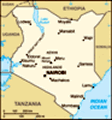Advertisement
At the end of our morning drive, we passed a young (5 years) elephant lost and distressed. Steve thought it had stayed in the wallow after its mother insisted on leaving. Eventually, through smell and distress cries, it should be able to reunite with its family; meanwhile it was vulnerable to predation.
Steve explained that wallows start as holes from ground termites. Then increasingly large animals use the soft, slightly hollowed space, and gradually the depression becomes big enough for all. Since it is a depression, even small amounts of water sink into it, making it cool and somewhat or wholly muddy.
We next visited the
Chimpanzee Sanctuary for orphaned chimps. This is the same one started in Rwanda by
Jane Goodall . When the
Rwandan civil war flared, she sought a safer place for the refuge and selected Ol Pejeta because of its well-known tight security.
Chimps are not native to Kenya, but the country used to be a prime part of the smuggling route. No more – the government tightened security a lot. Now any chimps rescued from poachers go to this sanctuary. Birth control is used to keep the population in check, since it is not a breeding centre, although

 Mary, 19 years
Mary, 19 years
Sweetwaters Chimpanzee Sanctuaryoccasionally birth control fails. I felt it was a sad place, partly because the need for it is fundamentally unjust. Also, these chimps don’t like humans, probably because they were so badly treated when younger. They are kept within a tall electrified fence, for the protection of captives and captors. Sixteen rangers are on staff to care for 25 chimps. Four of the staff conduct tours, and these guides were skilled at calling the chimps out by name for us to see. The animals seem to live in a limbo between needing stimulation from visitors and unconsciously longing for an unattainable natural life.
For lunch we returned to the camp and a couple hours off. The itinerary is so intense that the hours fled by in a short rest, shower and hair, and writing notes.
Our afternoon game drive started in some rain, welcome during the drought. The rain was too light to affect anything. The drivers lowered the raised tops of the vehicles, probably for less than an hour. We saw dozens of different animals: from Crown plovers to Egyptian geese, from Thompson gazelles and Grant gazelles to hartebeest, from eagles to guinea fowl, and so on
forever, it seemed. I learned that a bunch of rhinos is called a “crush”.
After about an hour, we entered the Ol’ Pejeta
rhino protection centre . The animal ambassador is Baraka, a tame rhino. Many years ago, he was blinded in the wild by a Cape Buffalo; one eye was gouged out by a horn and the other was badly infected. He was found by rangers and nursed back to health. Those who wanted, which I did, fed him some bush branches and stroked his horn. Why had I not expected it to be covered in fresh mud from a wallow?!
The guide led us through the
Morani Centre , a teaching museum with touchable exhibits of bones. We learned about the extraordinary differences in various animals’ skeletons, large and small. To me, the lion skull was surprisingly small. The vertebrae of the giraffe seemed anatomically stretched to about a foot long each. Elephant dung (hardened) was too large to hold in one hand. The hyena’s dung was white from the calcium remaining after crunching all the bones of its prey.
We bounced around for another hour at least. Zebras, buffalo, gazelles and warthogs were so plentiful that they
have already lost their specialness. When someone spotted something exciting, Steve drove to a good vantage point and stopped the vehicle. The roof was always raised, and we immediately stood up for a good view. Standing on the seat provided excellent views, so I just left my shoes off the whole time in the vehicle.
At the end of the afternoon, as we were turning onto the road back, we joined three other vehicles congregated in our way. A cheetah was lazing close to the road, disguised only by a bit of bush. It was heavily panting while digesting a huge meal made evident by its over-sized belly. It seemed quite placid, recognizing apparently that the vehicles were no threat. A thrilling end to a full day!
Dinner: beef stir-fry with pasta, French green beans, cauliflower, Tusker beer
Advertisement
Tot: 0.495s; Tpl: 0.013s; cc: 36; qc: 146; dbt: 0.1513s; 1; m:domysql w:travelblog (10.17.0.13); sld: 1;
; mem: 1.5mb

























Isabel Gibson
non-member comment
Wow! Great shots. And a great opportunity to be close to so many wild animals that they started to fade into the background, as it were. I guess we get accustomed to anything. With stops like the Morani Centre, your tour was clearly much more than a see-it/photograph-it tour (not that there's anything wrong with that). Your guides were clearly knowledgeable and focused on transferring some of that knowledge and appreciation.